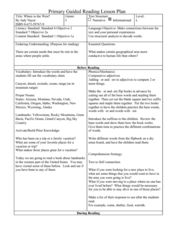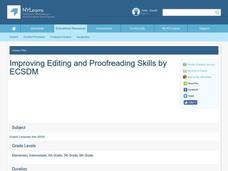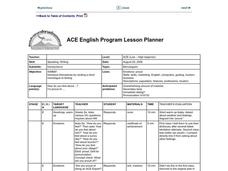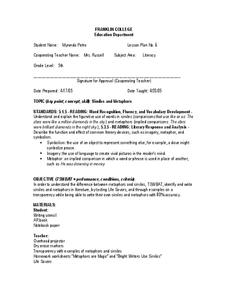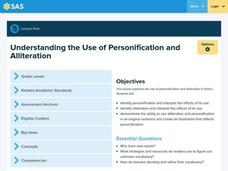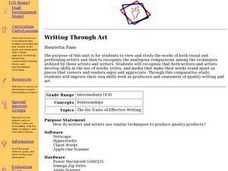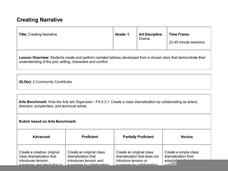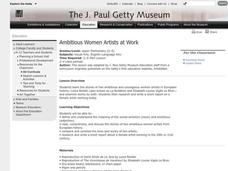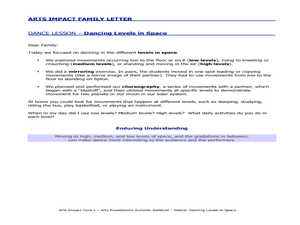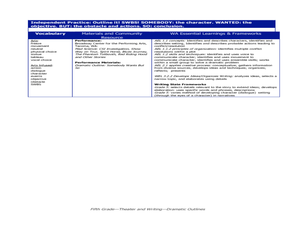Curated OER
"Where in the West" Guided Reading Lesson
Students complete a vocabulary chart, review proper/common nouns, discuss and review comparative adjectives and make "self to text" connections before reading. In this language arts lesson, comprehension questions are completed during...
Curated OER
Improving Editing and Proofreading Skills
Students explore language arts by correcting grammatical errors. In this proofreading lesson, students identify the importance of editing their own writing and demonstrate their proofreading abilities by correcting several incorrect...
Curated OER
Monologues
Students explore speech techniques by reading a monologue in their class. In this language arts lesson, students answer questions about their feelings on specific topics in order to get them comfortable while speaking. Students complete...
Curated OER
Details, Details, Details
Students add details to their writing. In this language arts lesson, students use details to enhance their writing. Students view a picture and write a paragraph about what they see. Students conference with another student to edit their...
Curated OER
Art and Artists
Students effectively gather and use information for research purposes. They comprehend the visual arts in relation to history and culture. Students practice note taking skills, and summarizing skills. They know and compare the...
Curated OER
The Art of Improvisation
Students explore the work of 3 for All. In this performing arts lesson, students watch a video segment about the improvisation group 3 for All, study improvisation, and participate in their own improvisation routines.
Curated OER
Similes and Metaphors
Reward your class with tasty treats while teaching them about simile and metaphor. After a teacher demo and explanation of simile and metaphor, pupils read books, looking for examples of these literary devices and copying them down....
Curated OER
Review of Personification and Alliteration
Learners review personification and alliteration. For this literary devices lesson, students use personification and alliteration in a sentence. Learners draw a picture reflecting personification.
Curated OER
Writing Through Art
Examine the works of visual and performing artists with upper graders. Using the works, they identify the comparisons among the techniques used. They will also review the six traits of effective writing and keep a writing journal...
Curated OER
"Knot" the Whole Truth: Writing a Modern-Day Story with a Tall Tale's Voice
Beyond Paul Bunyan and his blue ox, tall tales can be a great way to teach young writers about word choice and voice in their writing. Using Jerry Spinelli's Maniac Magee and the Six-Trait Writing process, they begin to write...
Curated OER
Writing a Television Advertisement
Pupils choose their favorite television show, craft and illustrate an advertisement for this show, and then write a short paragraph about why the show appeals to them. No provisions are made for children with limited or no viewing...
Curated OER
Perseverance: Keep Going
Kids evaluate world history events that show perseverance by creating artistic images. They investigate historic photographs and images which conjure up the feelings of perseverance, then utilize acrylic paints to capture the...
Curated OER
Sense Poetry
Access your young poets' senses and emotions with this activity, which guides them through the process of writing a "sense poem." After working on a sense poem as a class and modeling the procedure, individuals work on their own poems...
Hawaiʻi State Department of Education
Poems That Dance
Combine the elements of dance with the actions in a poem. Learners review basic grammar, write an action-packed cinquain poem, and then choreograph a dance based on their cinquains. After the dances are done, they'll discuss the elements...
Hawaiʻi State Department of Education
Creating Narrative
Plot, setting, characters, and conflict are common to both drama and narrative stories. Kids create narrated tableaus that show their understanding of the plot, setting, and conflict of a story they've recently read. The lesson...
Curated OER
Dance: Sharp and Smooth Energy Qualities
Learners use different qualities of movement to express themselves. In this lesson on movement, students use different qualities of energy and then use their experience as an inspiration for writing poetry.
Curated OER
Developing Writing Skills Through Japanese Folk Music
Students listen to Japanese folk songs to get inspired to create a writing piece about Japan. In this writing lesson, students use primary and secondary sources to add information about Japan.
Hawaiʻi State Department of Education
Illustrating Text
Ideas like this are highly effective for helping build better reading comprehension. The class listens to an excerpt from a grade-appropriate text, and they discuss what clues or words helped them visualize the scene. They then read a...
Curated OER
Theater Lesson: Modify My Action
Young scholars engage in a lesson that is about the meaning of a verb or adverb. They perform sketches with the subject matter of the words. The goal is for the actors to show the meaning of the verb or adverb with an action.
Curated OER
Ambitious Women Artists at Work
Examine the works of Luisa Roldan and Elisabeth Louise Vigee Le Brun. Learners view various pieces of art from each of the artists and read about their lives. They discuss the information and construct a Venn diagram, comparing the two...
Curated OER
Dancing Levels in Space
Learners practice mirroring human moves by performing a dance in class. In this physical education activity, students utilize different spaces around them to perform a dance expressing their full motion. Learners cooperate in...
Curated OER
Dramatic Outlines
Students write about main characters. In this dramatic writing lesson, students brainstorm character ideas. Students create actions and give the character a voice. Students act out the scene in groups and create a final draft.
Curated OER
Exaggerated Poetry
Students use physical poses and vocal choices to create emphasis in communication. In this exaggerated Poetry lesson, students use physical movement and vocal choices to exaggerate an expression make a connection between literary content...
Hawaiʻi State Department of Education
Dance Critic
What do writing and dance have in common? They both have a six-trait rubric for assessment. Just like a good story, a good dance must have a hook, beginning, middle, end, logical sequence, and a climax. Learners use a...
Other popular searches
- 5th Grade Language Arts
- 3rd Grade Language Arts
- 4th Grade Language Arts
- Second Grade Language Arts
- English Language Arts
- 1st Grade Language Arts
- Kindergarten Language Arts
- Language Arts Jeopardy Game
- First Grade Language Arts
- Language Arts School Projects
- Language Arts Lesson Plans
- Language Arts Games
